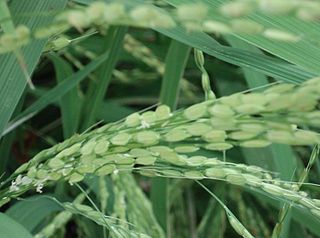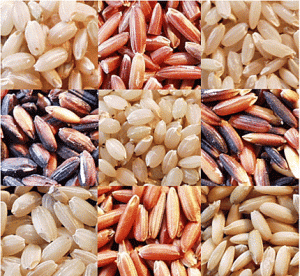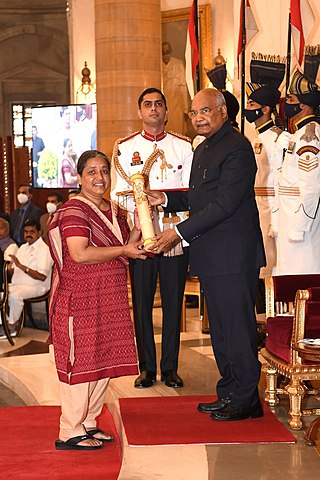Related Research Articles

Rice is a cereal grain and in its domesticated form is the staple food of over half of the world's population, particularly in Asia and Africa. Rice is the seed of the grass species Oryza sativa —or, much less commonly, Oryza glaberrima. Asian rice was domesticated in China some 13,500 to 8,200 years ago; African rice was domesticated in Africa about 3,000 years ago. Rice has become commonplace in many cultures worldwide; in 2021, 787 million tons were produced, placing it fourth after sugarcane, maize, and wheat. Only some 8% of rice is traded internationally. China, India, and Indonesia are the largest consumers of rice. A substantial amount of the rice produced in developing nations is lost after harvest through factors such as poor transport and storage. Rice yields can be reduced by pests including insects, rodents, and birds, as well as by weeds, and by diseases such as rice blast. Traditional rice polycultures such as rice-duck farming, and modern integrated pest management seek to control damage from pests in a sustainable way.
Organic farming, also known as organic agriculture or ecological farming or biological farming, is an agricultural system that emphasizes the use of naturally occurring, non-synthetic inputs such as compost manure, green manure, and bone meal and places emphasis on techniques such as crop rotation, companion planting, and mixed cropping. Biological pest control methods such as the fostering of insect predators are also encouraged. Organic agriculture can be defined as "an integrated farming system that strives for sustainability, the enhancement of soil fertility and biological diversity while, with rare exceptions, prohibiting synthetic pesticides, antibiotics, synthetic fertilizers, genetically modified organisms, and growth hormones". It originated early in the 20th century in reaction to rapidly changing farming practices. Certified organic agriculture today accounts for 70 million hectares globally, with over half of that total in Australia.

Sustainable agriculture is farming in sustainable ways meeting society's present food and textile needs, without compromising the ability for current or future generations to meet their needs. It can be based on an understanding of ecosystem services. There are many methods to increase the sustainability of agriculture. When developing agriculture within sustainable food systems, it is important to develop flexible business processes and farming practices. Agriculture has an enormous environmental footprint, playing a significant role in causing climate change, water scarcity, water pollution, land degradation, deforestation and other processes; it is simultaneously causing environmental changes and being impacted by these changes. Sustainable agriculture consists of environment friendly methods of farming that allow the production of crops or livestock without causing damage to human or natural systems. It involves preventing adverse effects on soil, water, biodiversity, and surrounding or downstream resources, as well as to those working or living on the farm or in neighboring areas. Elements of sustainable agriculture can include permaculture, agroforestry, mixed farming, multiple cropping, and crop rotation.

In agriculture, a terrace is a piece of sloped plane that has been cut into a series of successively receding flat surfaces or platforms, which resemble steps, for the purposes of more effective farming. This type of landscaping is therefore called terracing. Graduated terrace steps are commonly used to farm on hilly or mountainous terrain. Terraced fields decrease both erosion and surface runoff, and may be used to support growing crops that require irrigation, such as rice. The Rice Terraces of the Philippine Cordilleras have been designated as a UNESCO World Heritage Site because of the significance of this technique.

A paddy field is a flooded field of arable land used for growing semiaquatic crops, most notably rice and taro. It originates from the Neolithic rice-farming cultures of the Yangtze River basin in southern China, associated with pre-Austronesian and Hmong-Mien cultures. It was spread in prehistoric times by the expansion of Austronesian peoples to Island Southeast Asia, Madagascar, Melanesia, Micronesia, and Polynesia. The technology was also acquired by other cultures in mainland Asia for rice farming, spreading to East Asia, Mainland Southeast Asia, and South Asia.

Kuttanad is a river delta landscape region in the state of Kerala, India, known for its vast paddy fields and geographical peculiarities. It is in the Districts of Alappuzha, Kottayam and Pathanamthitta. The region has the lowest altitude in India, and is one of the few places in the world where farming is carried on around 1.2 to 3.0 metres below sea level,, using rice paddies largely located on reclaimed land amid the delta. Kuttanad is historically important in the ancient history of South India and is the major rice producer in the state. Farmers of Kuttanad are famous for Biosaline Farming. The United Nations Food and Agriculture Organization (FAO) has declared the Kuttanad Farming System as a Globally Important Agricultural Heritage System (GIAHS) in 2013.

The System of Rice Intensification (SRI) is a farming methodology that aims to increase the yield of rice while using fewer resources and reducing environmental impacts. The method was developed by a French Jesuit Father Henri de Laulanié in Madagascar and built upon decades of agricultural experimentation. SRI focuses on changing the management of plants, soil, water, and nutrients to create a more productive and sustainable system of rice cultivation.

Veeranpuzhaവീരന്പൂഴ is a lake in Kochi, Kerala, India. It is the northern extension of Vembanad Lake. From Kochi Azhi to Munambam Azhi, the Vembanad lake is popularly known as "Veeranpuzha". In the early 1980s there were regular ferry services from Munambam to Ernakulam. The area has large paddy fields devoid of human habitation. Non-availability of fresh water is a reason for lack of dense human settlements. Veeranpuzha was also known as Kadakkarakkayal കടക്കരക്കായല്

Ezhome is a census town in Kannur district in the Indian state of Kerala.

Pokkali is a unique saline tolerant rice variety that is cultivated using extensive aquaculture in an organic way in the water-logged coastal regions, spread in about 5000 hectares area in Alappuzha, Kottayam, Thrissur and Ernakulam districts of Kerala in Southern India. The brand Pokkali has received a GI tag from the Geographical Indications Registry Office, Chennai.

Farming systems in India are strategically utilized, according to the locations where they are most suitable. The farming systems that significantly contribute to the agriculture of India are subsistence farming, organic farming, industrial farming. Regions throughout India differ in types of farming they use; some are based on horticulture, ley farming, agroforestry, and many more. Due to India's geographical location, certain parts experience different climates, thus affecting each region's agricultural productivity differently. India is very dependent on its monsoon cycle for large crop yields. India's agriculture has an extensive background which goes back to at least 9 thousand years. In India, in the alluvial plains of the Indus River in Pakistan, the old cities of Mohenjo-Daro and Harappa experienced an apparent establishment of an organized farming urban culture. That society, known as the Harappan or Indus civilization, flourished until shortly after 4000 BP; it was much more comprehensive than those of Egypt or Babylonia and appeared earlier than analogous societies in northern China. Currently, the country holds the second position in agricultural production in the world. In 2007, agriculture and other industries made up more than 16% of India's GDP. Despite the steady decline in agriculture's contribution to the country's GDP, agriculture is the biggest industry in the country and plays a key role in the socio-economic growth of the country. India is the second-largest producer of wheat, rice, cotton, sugarcane, silk, groundnuts, and dozens more. It is also the second biggest harvester of vegetables and fruit, representing 8.6% and 10.9% of overall production, respectively. The major fruits produced by India are mangoes, papayas, sapota, and bananas. India also has the biggest number of livestock in the world, holding 281 million. In 2008, the country housed the second largest number of cattle in the world with 175 million.

Ezhome Rice varieties Ezhome-1 and Ezhome–2 are the first high yielding, non-lodging organic red rice varieties. They are designed for the saline-prone Kaipad rice fields of Kerala. They yield awn-less, non-shattering grains, and favourable cooking qualities, better than local cultivars. The average yields of ‘Ezhome-1’ and ‘Ezhome-2’ are 3.5 tonnes/ha and 3.2 tonnes/ha respectively under close-planted and no-management conditions of Kaipad. This yield is 70% and 60% more than that of local cultivars. These varieties differ in duration, have distinct morphological and qualitative traits, and have different salinity tolerance mechanisms, imparting varietal diversity to the unique ecosystem of Kaipad.

Thrissur-Ponnani Kole Wetlands is a wetland lying in Thrissur and Malappuram districts in Kerala, India. It gives 40 per cent of the Kerala’s rice requirement and acts as a natural drainage system for Ponnani city, Thrissur city, Thrissur District, and Malappuram district. The Kole Wetlands is one of largest, highly productive and threatened wetlands in Kerala and lie on the Central Asian Flyway of migratory birds.
Saltwater aquaponics is a combination of plant cultivation and fish rearing, systems with similarities to standard aquaponics, except that it uses saltwater instead of the more commonly used freshwater. In some instances, this may be diluted saltwater. The concept is being researched as a sustainable way to eliminate the stresses that are put on local environments by conventional fish farming practices who expel wastewater into the coastal zones, all while creating complementary crops.

Rice in Sri Lanka has played an important role in the country's functioning and survival for centuries. Rice continues to be a staple of traditional Sri Lankan cuisine today.

Pizhala is an island village, one among the fourteen islands of Kadamakkudy archipelago, located near to the main land of the city Ernakulam. The island is surrounded by tributaries of river Periyar. Pizhala island is part of Kadamakkudy village of Kanayannur taluk in Ernakulam district in the state of Kerala, India.
The Central Soil Salinity Research Institute (CSSRI) is an autonomous institute of higher learning, established under the umbrella of Indian Council of Agricultural Research (ICAR) by the Ministry of Agriculture, Government of India for advanced research in the field of soil sciences. The institute is located on Kachawa Road in Karnal, in the state of Haryana, 125 km (78 mi) from the Indian capital of New Delhi.

Gandhakasala rice is a variety of rice cultivated by the farmers in Wayanad District in Kerala. This is a scented variety of rice grown mostly by the members of the tribal communities of in Panamaram, Sultan Bathery, and Mananthavady areas in Wayanad. As of 2010, gandhkasala is cultivated in an area of 327 hectares and jeerakasala in 22 hectares.

Sabarmatee is an Indian conservationist and farmer living in Nayagarh district in the state of Odisha. She works with a non-governmental organization called Sambhav which was visualised by her father Padma Shri Prof Radhamohan that promotes organic farming and conservation of indigenous varieties besides doing many other activities. The achievements of Sabarmatee were recognised in 2018, when she received the Nari Shakti Puraskar and in 2020 with the Padma Shri.

Madhupur pineapple is an agricultural product cultivated in the Madhupur region of Tangail district, Bangladesh. Madhupur pineapple received Geographical Indication (GI) tag on 24 September 2024.
References
- ↑ "GI tag for Kaipad rice to boost cultivation". The Hindu. 5 August 2013. Retrieved 9 October 2018– via www.thehindu.com.
- ↑ Sudhi, K.S. (19 January 2010). "Crops cleared for farming" (HTML). The Hindu. Retrieved 9 October 2018.
The two salinity-resistant varieties, 'Ezhome 1 and 2,' were developed for Kaippad area of Kannur.